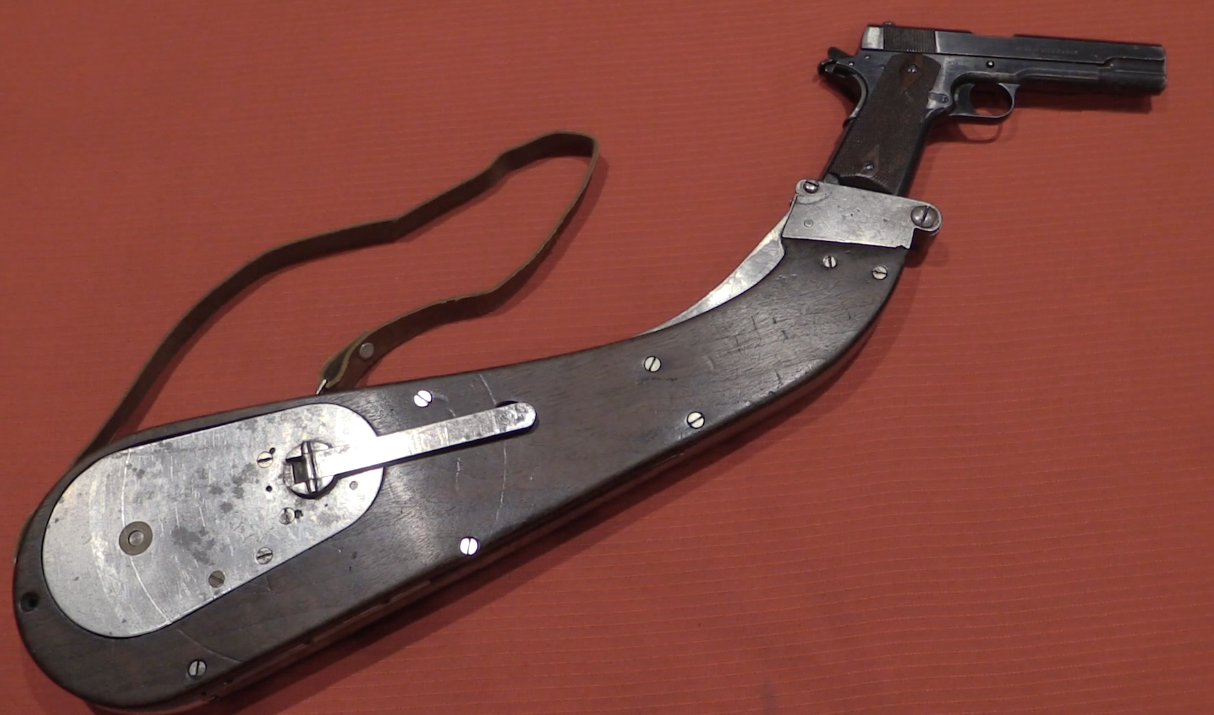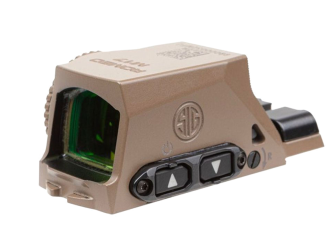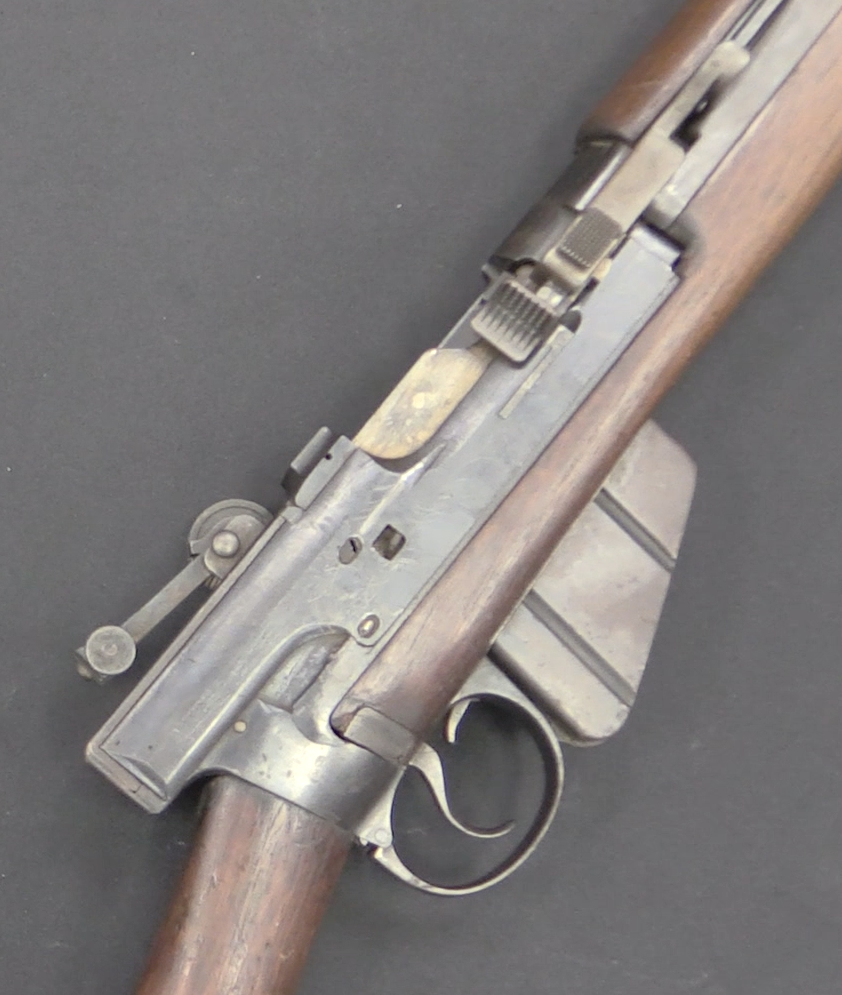The Remington Model 8 was one of the first successful self-loading rifles introduced to the commercial market, and it was designed by none other than John Browning. It was an expensive rifle, but popular for its power and reliability. In the 1920s, an entrepreneur founded the Peace Officer Equipment Company to sell police gear in St Joseph, Missouri. He would design a conversion to the Remington Model 8 to replace its fixed 5-round magazine with larger detachable magazines (5-, 10-, and 15-round, with 15-round being the most common by far).
POEC made and sold the conversion until about 1936, when Remington replaced the Model 8 with the slightly improved Model 81. At that point, Remington licensed the magazine conversion themselves, and offered it as a factory option, under the Special Police name. Remington had big hopes for the rifle, but only a few hundred were sold, with the LA County Sheriff being the single largest customer, ordering 200 of them. This rifle is one of the LA guns, number 40 of their order.




Do you know if the color filled lettering was from the factory or added later on? It seems to me that I’ve seen one of these guns somewhere along the gun show path and I can’t recall if it was an LA Sheriff gun, but I think it too had the “gaudy” lettering.
It’s interesting to see factory paint holding up so well after many years of hard use. The big bright “gaudy” lettering saying “PROPERTY OF …” was ostensibly intended to loudly scream out in no uncertain terms to anyone who came across it that the gun was indeed stolen property. (It’s certainly not the sort of thing I’d welcome seeing on items being sold out of the trunk of a car late at night.)
Personally, I’d refuse to ever buy anything with that kind of logo on it, but that’s just me. I’ve simply had too many run-ins with overly-suspicious authorities in my life that I don’t relish the hassle of another one. I’m sure that more than a few cops out there are going to jump to the conclusion that it’s stolen property — perhaps even stolen from a fellow officer — unless and until they’re thoroughly convinced that it doesn’t really mean what it says it means. (Not everyone, after all, is a firearm historian — to many people, a gun is simply a gun.)
AA,
Well, a low key stance and caution are certainly most desirable when dealing with firearms either in the sale or acquisition or posession. But I hate to tell you the the inscribing, etching, painting, or use of the infamous electric-pencil to establish ownership carries absolutely no weight nor meaning whatsoever.
Back in a day, (as opposed to back in “The Day”…there’ve been so many,) I used to process firearm confiscations, turn-ins, sub-rosa acquisitions, parolee violations and any number of “repurposings” of selected proscribed items from the general public.
From our local “Projects,” Officers would regularly come in with a 55 gal drum filled to the brim with U-Name-It projectile launching devices…and not just firearms but slingshots, bows with arrows, machetes, crossbows and, believe it or not, bonafide vintage zip-guns.
Often we’d get the story along with them.
—my favorite was the yokel who tried a street robbery armed with a bowling ball. And another robbery where the street Duff actually stole a bowling ball, ran with it and was suprised when the owner had no trouble catching him. That one did not end well for the Duff.
Anyway, we used to buy the drums based on the poundage. The items were divided roughly into 3 catagories; 1:) Really nice items, like vintage target pieces turned in by widows or just “I don’t want this any more” items and like that. 2:) Bread and butter general issue resaleable stuff like Cop revolvers. 3:) Real Garbage. We really enjoyed that category because it’s really fun to smash a Saturday Nigh Specal flat with a ball-peen hammer. Cast Zinc melts nicely into a neat puddle when introduced to a propane torch, and anything more resistant puddles up nicely with acytelene. Fun.
Also a good way to legally improve one’s own collection.
And now my point. Who do you think was bringing all these items in? Yup, the Cops. Every time a local Law Enforcement organization upgraded their hardware, we’d get their old stuff to resell to the general public. As often as not they’d be engraved with their parent organization’s title or sometimes even their official logo. Really. Occasionally the items were not technically firearms but perhaps not allowed in that particular venue. I had to give back a folding stock for a shotgun that had been gifted to me by a…certain federal agency…that stated “Property of the ***.” (Insert desired three-capitol-lettered agency of your choice here.) I’d have loved to have kept that one but it made my social circle somewhat nervous as they didn’t see the humor.
I have a Springfield rifle clearly more than a century old, but some idiot back when took his electric-pen to it; I have a Leica camera, otherwise extremely valuable but some moron in the 1950’s thought engraving his social security number with an electric pen (badly) was a good idea. (For those with an itchy electric-pen, the Social Security Administration WILL NOT GIVE OUT YOUR IDENTITY to recover your Leica, Rolex, Colt Python, or even Ferrari.
Again, point being, the world is full of otherwise insanely valuable stuff, like overstrike Thompsons and such and sometimes that even increases the value. But usually it doesn’t. Most likely it either comes from legitimate sources that neither increase or decrease the value (Say your Great Uncle used to be the Desk Sarge in Possum Trot, Arkansas and this was his Cap ‘n Ball.
But rather beware “The Genuwine Honestlee wiUld bill hiccup personally owned” 1911 Coult” automatical . No matter however nicely engraved.
Pss, I have a certain deceased despots personalities sidearm for sal. Sale. Nice engraving on the grip says “A. H.” I'”no expert but supposed to belong to somebody important. Panda style, alternate gold & silver barrel, handle, toggle thingee on top. Really pretty. Has “Flinstones engraving moteteef.
😀
Ah yes, the electric pencil fad. ^__^
This was meant to, 1) Prevent Theft … an otherwise valuable item, now not so easily fenced since it’s got these numbers scratched on it. 2) Help The Police Identify Your Stolen Property … “Officer, all you have to do is look for “1234567890” scratched all over my stolen property! See, I’ve got a list on this paper!”
Eventually folks figured out that it wasn’t all that helpful, either to the police or to themselves when they decided they wanted to sell their own stuff. (heh)
If police service weapons were to get the same treatment as motor vehicles before being sold to the public, then those “PROPERTY OF … ” receiver markings probably should be ground off with a dremel.
Let’s take the situation of used police cars being decommissioned and sold…
Possibly because the sun would have faded the paint underneath the letters, and so simply removing the decals would have had the underlying (unfaded) paint faintly spelling out words like “police” would be reason to take a grinder and remove the paint to bare metal, then take a can of cheap spray paint (typically several shades off) to cover over the damage. The removal of equipment and electronics also leaves a mess of damage. Maybe not all cities prepare their decommissioned cars this crudely, but it’s annoying that at least some did.
They literally destroy the surface of the vehicle, going far beyond a reasonable attempt to ensure that the public does not mistake the car for a working police cruiser. But even if we assume that the potential mis-identity of a police squad car is something that must be avoided at all costs, then why is it that city-owned utility vehicles (and other non-emergency vehicles) get the same overly-destructive treatment before they can be sold to the public?
It’s been a long time since I’ve been to used-car (“dealer”) auctions, so it’s possible that it’s not done this way any more, but it’s just something that used to irritate me as a car buyer. Thankfully police service weapons are not typically treated in similar fashion, instead leaving that “disinfection” option to the buyer.
The company that built the conversion was associated with the Hillyard Company of St. Joseph, MO. They are still in business making floor finishes.
Seems almost obligatory to point out that Frank Hamer used a model in the ambush of the infamous bank robbers Bonnie and Clyde. That ambush leads into an interesting point. A lot of law enforcement officers who used the rifles did not bother with the Peace Officer’s Equip models. There is some controversy if all of the model 8’s (there was at least one) used in the ambush were modified for detachable magazines or were stock factory models. In 1938 when the FBI traded in the self loading Winchester 1907 for the Remington 81 they had their own variation built (it used a receiver sight, among other things) but stuck with the fixed 5 round magazine. It seems that a lot of law enforcement liked the gun but did not see the point at the time of going with larger magazines.
There were only two Model 8s in the ambush- Hamer’s, in .35 Remington, and another with a standard magazine in 30 Remington. One deputy had an M1921 Thompson with a 100-round drum magazine (!), and the other deputy had a Winchester M1892 in .44-40 WCF.
Autopsy results showed that Barrow and Parker died from two gunshot wounds to their heads, both .44-40s. The deputy with the Winchester fired two rounds, aiming through the Ford’s windshield.
The pair were apparently already dead before the rest of the party riddled the car with bullets.
As Bill Jordan said, “Speed is fine, but accuracy is final”.
cheers
eon
Ah, the memories. My Dad had a nice Model 8 in .25 Rem back in the day. Great old gun. Unfortunately he sold it before I got into firearms. Nuts.
I am not surprised that this wasn’t too popular. The Model 81 wasn’t any cheaper than the original product and it was likely not easy to maintain. Until recently in terms of decades most police departments issued revolvers and shotguns, with rifles restricted to the SWAT units. Did I mess up?
The regular (not the “Police Model”) model 81 and model 8 were somewhat popular with law enforcement during and just after the prohibition gangster era. The FBI issued a regular model 81, not the police model, as did the Border Patrol and a number of large-city police departments. During that era some criminals drove cars that the normal 32 or 38 caliber revolver rounds would not penetrate, and some criminals even took to wearing early bullet proof vests. A 35 caliber Model 8 would be a good rifle to have in that case. The issue was that while the regular 5-shot model was a little popular with law enforcement, only a few agencies saw the need to go to a rifle with higher-capacity. Either what is the point to all those rounds, or it would interfere with prone shooting and make one a larger target, or they did not like the cost.
Post-world war II most regular police units went to shot guns. The idea being that they would not over-penetrate and injure civilians, they were generally non-threating in appearance, and they did not require a lot of training to become proficient with. The SWAT team concept really did not get started until the mid-1970’s and that was largely in response to the disastrous response of regular German police units to the terrorist incident at the 1972 Olympics. Large city departments thought that could happen in their city some day so they prepared to deal with well equipped and trained terrorist organizations. Then to justify their existence they started serving search warrants and such. Those teams were generally equipped with rifles. At first Mini-14’s were popular and AR-180’s were even used by Los Angeles SWAT circa 1980, then eventually everyone went with AR-15’s and MP-5’s, then just to AR-15’s.
Another issue that shouldn’t be ignored is the human tendency to use (or abuse) whatever resources are available. We shouldn’t be surprised when we give police massive firepower that they might actually use much more than the minimum needed for the task at hand.
It’s ironic that the one definitive time that a SWAT team was actually called for, in the recent “Black Lives Matter” Dallas anti-police sniper case, they were afraid to use it because they feared that the swatters might get hurt, and so police sent a drone-delivered bomb instead. We may soon be upon the age when the Robocop replaces the SWAT team for any and all dangerous work. And anyway, robots can’t be racist, can they?
I have a model 8 with a factory mounted scope. Trying to find 30 Rem ammo so I can fire it.